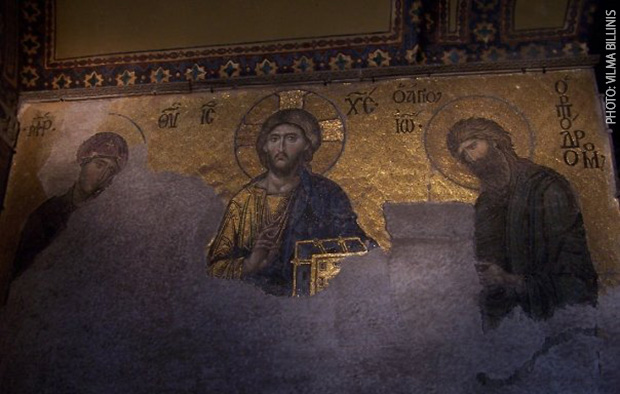- FOKION AVGERINOS – DR. IKE: Athletic Director, Youth Mentor, and Healer
- American Hellenic Institute’s Golden Jubilee Celebration
- Leadership 100 Concludes 33rd Annual Conference in Naples, Florida
- Louie Psihoyos latest doc-series shocks the medical community The Oscar–winning director talks to NEO
- Meet Sam Vartholomeos: Greek-American actor
Edifice Complex: Erdogan and Agia Sophia

Alexander Billinis
[sws_pullquote_left]
Memo
To: “Sultan“ Erdogan
From: Emperor Justinian
Subject: Agia Sophia
YOU DIDN’T BUILD THAT!
[/sws_pullquote_left]
It was not three months ago, when writing to express my outrage at the conversion of Trabzon’s Agia Sophia Cathedral-Museum into a mosque, that I wondered out loud if “Sultan” Erdogan’s next move would be to convert Istanbul’s Agia Sophia into a mosque.
That hour, may, in fact, be close at hand.
Agia Sophia is sacred to Greeks and all other peoples (Serbs, Bulgarians, Romanians, Russians, Ukrainians, Georgians and others) who share the Byzantine Orthodox heritage. This temple on the Bosporus is a sublime attempt to capture the omniscience and light of God’s Love in earthly architecture, but it is far more than that.
It is, of course, sacred to Muslim Turks as well, as Ayasofya Mosque, for hundreds of years, to be precise from May 30, 1453 until 1935, when the Turkish Council of Ministers decreed that it should be a museum.
Whatever else may be said of the Turkish Republic or of its founder, Kemal Attaturk, this move was both enlightened and honest. They recognized that they were the custodians of one of the world’s most important and sacred structures, and that the history of this structure and of the Turks’ possession of Istanbul was, as they say, “complicated.” By having Agia Sophia as a museum, anyone, regardless of belief or lack thereof, could partake of the sublimity of a structure so amazing that, as a pagan Rus envoy once wrote, “We did not know if we were in Heaven or on Earth.” By operating as a museum, mosaics covered by plaster since the Fall of Constantinople were once again “liberated,” by expert art historians and restoration specialists, often as not Americans, and we once again could lay our eyes on the otherworldly beauty of the Byzantine mosaics therein.
I recall my own visit, a few years ago. As amazing as the domes and the vast interior with thousands of points of illumination were, for me, it was the mosaics, in particular that of Christ Himself, made out of millions of pieces, who looked so alive as if He were drawing breath, that touched my soul forever. I know I am biased, as a Greek, but I would enjoy being challenged to find any work of art so beautifully depicting Divinity and Humanity. After all, treasures of art are a global commons and must be celebrated, rather than obscured, and due credit ought to be given to the actual artists, and to the actual people who “built that.”
The very thought that now, under Muslim religious requirements, that such sublime (and yes, sacred) works of art, revealed again to the world after half a millennium of being hidden, would be consigned, either to the veil, or to plastering over once again, is unbearable. It is an act that only a deeply irresponsible, destructive and insecure regime would do. Perhaps that, in fact, is the real issue here.
Don’t get me wrong. I deeply respect Islam, and I think that Turkish Islamic architecture, clearly descending from Byzantine norms, is exquisite. The Blue Mosque nearby Agia Sophia is easily one of the most beautiful buildings I have ever seen, and the intricate floral and calligraphic designs inside mosques are a beautiful depiction of the Divine based on their traditions. I have longed to go to Edirne, Adrianople, in Turkish Western Thrace, as I understand the mosques there are beautiful and off the beaten path of tourism.
My favorite mosque is, in fact, in Hungary, in the village of Siklos, dating from Suleiman the Magnificent’s conquest in the 1550s and lovingly restored by the Hungarian antiquities authorities, which now hosts a small community of Bosnian Muslims. Note the difference; the Hungarians restored the mosque and retained its religious identity; the Turks hijack churches they did not build and change them into mosques. President Obama’s famous comment, “You didn’t build that!” comes to mind. To the best of my knowledge, in all of my travels in the Balkans and Hungary, I have only found two mosques converted to churches, one in Pecs, Hungary, and one in Kavala, Greece. In Turkey, there are hundreds, if not thousands, of churches or monasteries converted to mosques. To turn Agia Sophia into a mosque now is only an act of deliberate cultural obliteration unbecoming of a great nation that Turkey aspires to be, and I believe can be.
Imagine if the Israelis sought to change the Dome of the Rock into a synagogue, as it was once the site of Solomon’s Temple, or if, for example, the Greek government decided to change the Parthenon into the church it once was because standing alone it recalls the pagan Classical religion of Ancient Greece rather than Orthodox Christianity, the established religion in Greece. Wouldn’t that provocative, and frankly, ridiculous? The world would be outraged. Where is the world’s outrage today?
It is time to call out the Turkish authorities on this attempt, and to call it what it is. An act of low politics masked as piety, is pitiful in any country, by any religion. Thankfully, we are seeing less and less of this globally. Turkey has not evolved to this point yet, and in fact is regressing into a culture of insecurity and the hijacking, and obliterating, of others’ cultures. Such a country is dangerous to others, and to itself.












0 comments